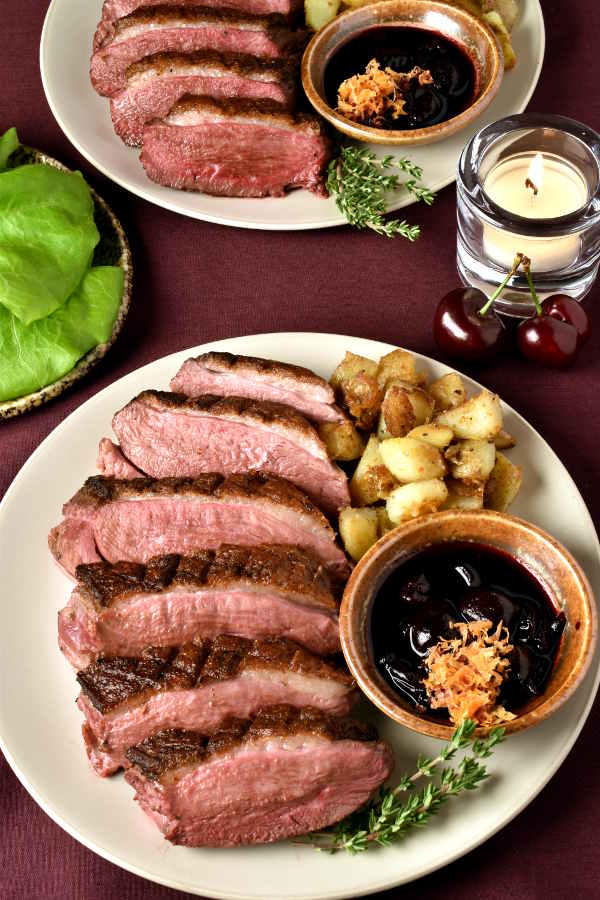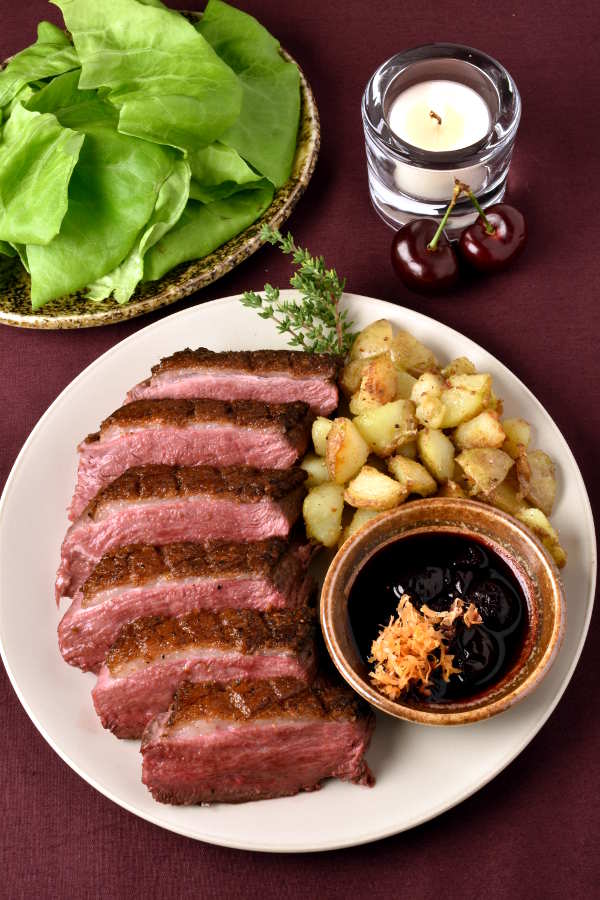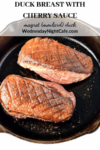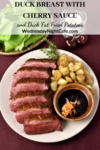Juicy duck, crispy skin, and a sweet cherry sauce to balance it out. Fry potatoes with the extra duck fat!

Hey guys,
It’s my first blog post. I’ve casually joked about starting a food blog for several years. I follow so many, and it was always in the back of my mind that I’d one day start my own. Like, I would make up a recipe and tell people “I have to post this on my food blog,” and they’d ask me “Oh, what’s your blog?” and I’d say “Just kidding, I don’t have one.” I never really thought it would happen.
Until about a year ago, when I started thinking, why not? I love reading food blogs, and I always think about what I would post if I had my own. Why not actually do it? I did some research. I bought a new camera. Jonathan bought me a fancy lens.
The past few months, I’ve been practicing my food styling and photography. It’s absolutely horrifying when I look back at a picture I took in February and remember that, at the time, I thought it was good. I have improved so much in just a few months. I can only hope I’ll one day look back at this first post and be embarrassed at how bad these pictures are because I’ll have improved so much more.
Well, a girl can dream.
The question now is, how do I know I’m ready to share the photos with the world? The thing about creative work is, if you wait until it’s perfect, you’ll never share it. I have to start somewhere, and I’ve, perhaps foolishly, decided I’m ready. I want to keep learning and improving, and I’m open to feedback on the recipes, photography tips, suggestions, and comments. You can also read more about the blog here.
Ok, let’s get to what you really came here for: the food.
The hardest part of this recipe will be finding the duck breast. You might have to make a trip to a different supermarket from where you normally shop or order it online. But when you want an extra special dinner, it’s worth the effort.
There are two different types of duck you’re likely to see for sale. Pekin ducks, also called Long Island Pekin, American Pekin, and White Pekin, are smaller. If you buy “boneless duck breast” in a supermarket and the label doesn’t specifically say what kind of duck it is, this is likely what you’re getting. The first time I made this recipe, I bought Pekin. The breast pieces were about six ounces each, and I needed two to serve one person. If you substitute Pekin breasts in this recipe, the cook time will also be shorter considering the smaller size.
You’ll also see Moulard duck for sale. The breasts are called magret in French and sometimes sold under that name. Moulard ducks are crosses between Pekin and Muscovy ducks. These ducks are bred for their livers to be used in foie gras. Each breast piece will be around 14 ounces to one pound. The meat has a stronger flavor than Pekin. Eating a magret is like eating a steak.
That’s right. Duck breast is considered a red meat, and like steak, many people prefer to eat it medium-rare as opposed to well done. The USDA is not one of those people. They recommend cooking duck to an internal temperature of 165oF, same as chicken. (It is possible the meat will still be slightly pink at this temperature.) Personally I prefer duck cooked to medium. Well done duck breast will be dry and chewy, but certainly still edible if that’s a concern for you.
Here’s my cooked-to-medium magret. You can also see the crisscross pattern used to score the skin.

A seared magret is delicious on its own. But I think the crispy fatty skin and bold flavor of the meat pairs well with a sweet, fruity sauce. The cherry sauce takes just a few minutes to make and adds that little extra special touch. For a side, I made use of the rendered fat to fry up some potatoes while the duck was cooking.

When you’re done making this recipe, you’ll have some extra duck fat leftover. Save this. You can use it to make more fried potatoes, make duck confit, or really to replace any other fat in cooking. I read the French even use it in baking. Or you could put it in a baggie in the freezer for later use and then throw it out six months later when you are cleaning out your freezer.
No, don’t do that.


Duck Breast with Cherry Sauce and Duck Fat Fried Potatoes
Ingredients
- 2 tablespoons butter, divided
- 1 pound potatoes, cut into 1/2 inch cubes
- 2 pieces Moulard duck breast (called magret), about 14 ounces each
- salt and pepper
- 1/2 cup frozen pitted dark sweet cherries, thawed and halved
- 1/3 cup chicken broth
- 3 tablespoons red wine
- 1 tablespoon honey
- 1 teaspoon orange zest
Instructions
- Begin frying potatoes: Melt 1 tablespoon butter in a skillet over medium heat. Add potatoes and fry for 10 minutes, stirring often. Turn off heat and set aside.
- Meanwhile, prepare duck: Pat duck dry with paper towels. Season with salt and pepper on both sides. Run a knife diagonally over the skin to score it in a crisscross pattern, being careful not to cut all the way through the skin. This will help the fat render (meaning change from solid form to liquid form) as it cooks.
- Begin cooking duck: Heat a cast iron skillet over medium heat. Add duck, skin side down. Cook 8 minutes without moving. Pick up the skillet with one hand and use tongs or the back of a spoon with your other hand to hold the duck against the skillet. Carefully pour the melted duck fat out of the pan into a bowl. Put the skillet back on the stove.
- Continue frying potatoes: Add 2 tablespoons of the melted duck fat to the skillet with the potatoes. Put the potatoes back on medium heat and fry, stirring occasionally, until fully cooked and crispy, 15 to 20 more minutes. Add salt and pepper to taste.
- While potatoes fry, continue cooking duck: Turn heat down to medium-low. Continue cooking duck until the skin has rendered most of its fat and is crispy, another 5 to 10 minutes. Every few minutes, as liquid fat collects in the pan, pour it out into the bowl. When skin is crispy, flip the duck breasts over and cook for another 3 to 8 minutes, depending how you like it cooked. Remove duck to a plate and cover loosely with aluminum foil. Let rest for 10 minutes.
- While duck is resting, make the sauce: Use the same skillet you cooked the duck in, but pour off excess fat. Add cherries, broth, wine, honey, and orange zest. Bring to a boil over medium high heat and cook until sauce develops a syrupy consistency, about 3 minutes. Remove from heat. Add remaining 1 tablespoon butter and stir until melted. Add salt and pepper to taste.
- To serve: Slice duck breasts against the grain. Serve with sauce and potatoes.
Bon Appétit!



Where did you buy your duck breasts, they look good!
Wegmans near me has them in stock about 2/3 the time.